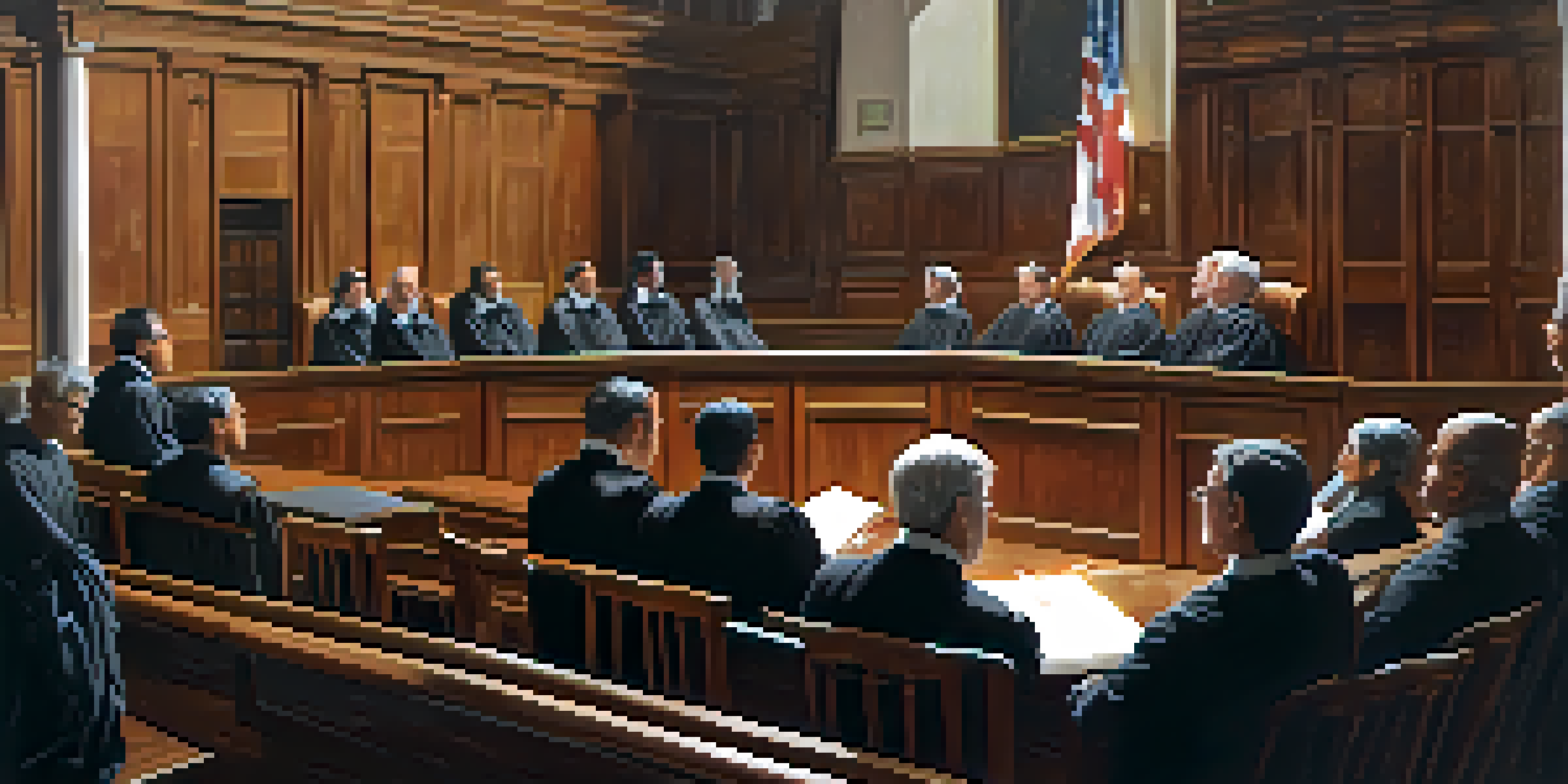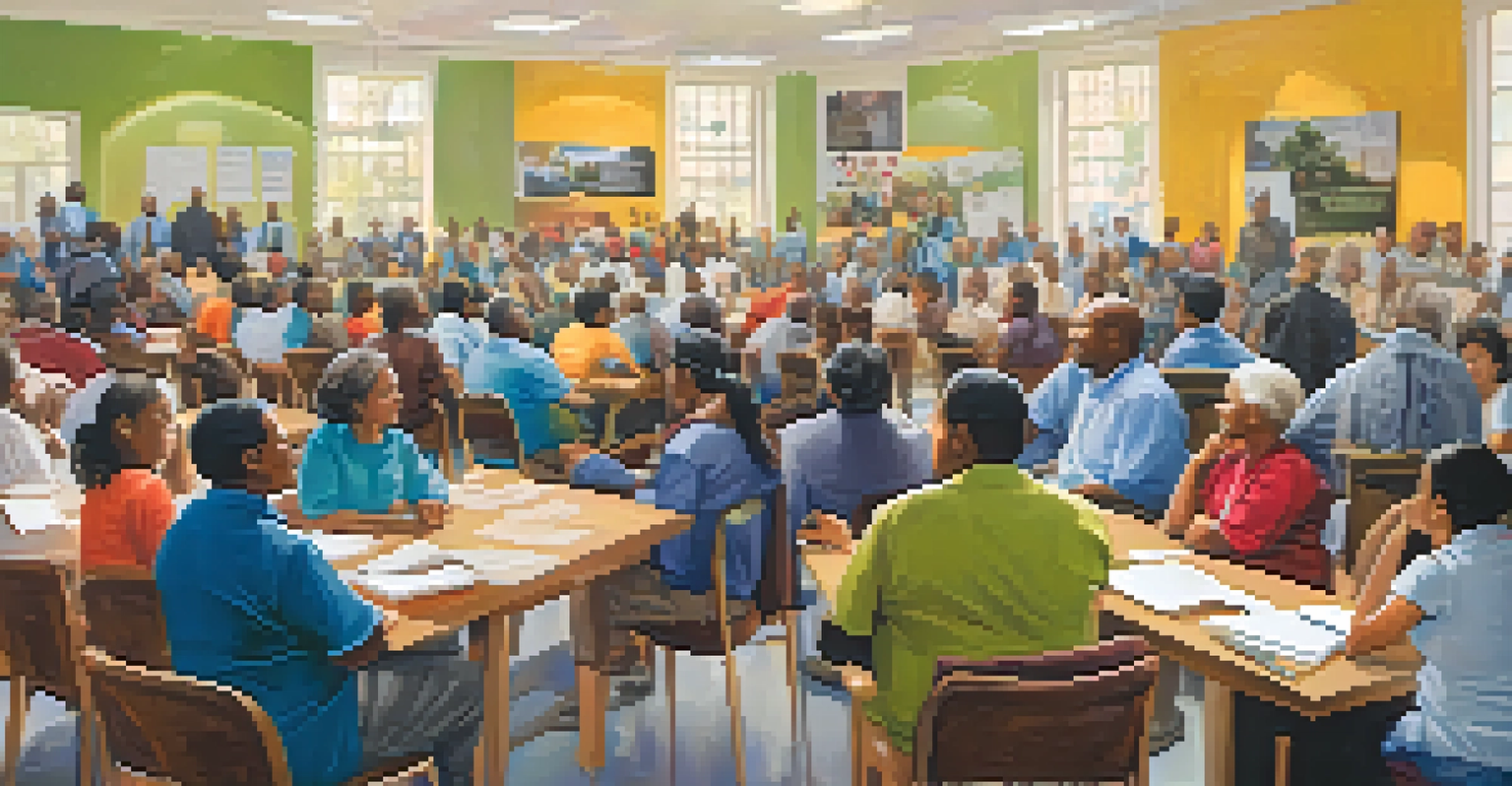Judicial System in Texas: Role in Politics and Governance

Overview of the Texas Judicial System Structure
The Texas judicial system is known for its unique structure, comprising multiple levels of courts that address various legal matters. At the base, there are municipal and justice courts, which handle minor offenses and civil cases. Moving up, district courts deal with serious criminal cases and significant civil disputes. This tiered approach ensures that cases are managed efficiently and appropriately, reflecting the state's commitment to justice.
The law is reason, free from passion.
Above the district courts, the Texas Court of Appeals serves as an intermediary appellate court, reviewing decisions made by lower courts. This layer allows for oversight and correction of potential errors, ensuring that justice is served fairly. At the pinnacle of this system is the Texas Supreme Court, which focuses solely on civil cases, while the Texas Court of Criminal Appeals handles criminal cases. This clear delineation of roles is crucial in maintaining a balanced judicial system.
Together, these courts form a cohesive structure that not only administers justice but also influences the political landscape of Texas. The judges appointed or elected to these courts can significantly impact legislation and public policy through their rulings, making the judicial system a pivotal player in the governance of the state.
Judicial Elections: A Unique Aspect of Texas Politics
Texas stands out among many states due to its judicial elections, where judges are elected rather than appointed. This system allows the public to have a direct say in who interprets the law, making judicial accountability a key feature. However, it also raises concerns about the influence of campaign financing on judicial impartiality. Candidates often rely on significant donations to run their campaigns, leading to questions about whether justice can truly be served impartially.

Moreover, the electoral nature of the judiciary can sometimes politicize the role of judges, as they may feel pressured to align with popular opinion or party ideologies. This dynamic can create a challenging environment where legal principles must contend with public sentiment. For instance, high-profile cases often attract media attention, which can sway public perception and, subsequently, judicial actions.
Texas Judicial Elections Impact Justice
The unique system of electing judges in Texas allows for public accountability but raises concerns about impartiality due to campaign financing.
Despite these challenges, judicial elections in Texas foster a sense of civic engagement, encouraging citizens to be informed about the individuals who hold significant power over legal interpretations. This engagement can lead to a more robust discussion about justice and governance, ultimately shaping the political landscape in meaningful ways.
The Role of the Judicial System in Shaping Public Policy
The Texas judicial system plays a critical role in shaping public policy through its interpretations of laws and the Constitution. Court rulings can set precedents that influence legislation, impacting everything from education to healthcare. For example, decisions regarding funding for public schools can directly affect educational equity across the state, highlighting how judicial actions reverberate through various aspects of governance.
Injustice anywhere is a threat to justice everywhere.
Moreover, the judiciary often serves as a check on legislative and executive power, ensuring that laws align with constitutional principles. This balance is essential in a democratic society, as it prevents any one branch of government from overstepping its bounds. When courts rule against a law or executive action, it not only reinforces the rule of law but also prompts lawmakers to reconsider their approaches.
In this way, the judicial system becomes an arena for political debate, where issues are contested and resolved through legal channels. This interplay between law and politics exemplifies the dynamic nature of governance in Texas, demonstrating that the judiciary is not merely a passive entity but an active participant in shaping the state’s political landscape.
Judicial Review: Ensuring Constitutionality in Governance
Judicial review is a fundamental power held by the Texas judiciary, allowing courts to assess the constitutionality of laws and government actions. This process is vital for upholding the rights of citizens and ensuring that legislative measures do not infringe upon constitutional protections. For instance, challenges to voter ID laws or abortion regulations often make their way through the courts, highlighting the judiciary's role in defending individual rights.
The power of judicial review also serves as a critical mechanism for maintaining the balance of power among the branches of government. When laws are challenged, the courts have the authority to invalidate those that conflict with constitutional provisions. This guardianship role reinforces the principle that no law is above the Constitution, making it a cornerstone of democratic governance.
Judiciary Shapes Texas Public Policy
Court rulings in Texas play a crucial role in influencing legislation and public policy across various sectors, from education to healthcare.
However, judicial review can be contentious, especially when decisions are perceived as politically motivated. This tension underscores the importance of an independent judiciary, as impartial rulings are essential for fostering public trust and confidence in the legal system. Ultimately, judicial review is not just a legal process; it is a fundamental aspect of governance that shapes the rights and freedoms of Texans.
The Interaction Between the Judiciary and State Legislature
The relationship between the Texas judiciary and the state legislature is complex and multifaceted, often characterized by tension and collaboration. Legislators create laws that the judiciary interprets, leading to a continuous dialogue between these two branches of government. This interaction is essential for effective governance, ensuring that laws reflect the needs and values of the community while adhering to constitutional guidelines.
However, conflicts can arise when the courts strike down legislation or rule against the interests of lawmakers. Such instances can lead to political backlash, with some legislators calling for reforms to limit judicial power. This dynamic illustrates the ongoing struggle for balance, as both branches seek to assert their authority while remaining accountable to the public they serve.
Despite these challenges, the collaboration between the judiciary and the legislature can lead to positive changes in public policy. When lawmakers consider judicial feedback and rulings, they can craft more effective and constitutionally sound legislation. This synergy ultimately enhances the governance of Texas, fostering a more responsive and responsible political environment.
Impact of Public Opinion on Judicial Decision-Making
Public opinion significantly influences judicial decision-making in Texas, often acting as a double-edged sword. On one hand, judges must consider the societal implications of their rulings, especially in cases that garner widespread attention. This awareness can help ensure that the judiciary remains relevant and connected to the values of the community it serves, reflecting societal shifts in areas like civil rights and criminal justice.
On the other hand, the pressure of public sentiment can lead to concerns about judicial independence. Judges may feel compelled to align their decisions with popular opinion, potentially compromising their commitment to upholding the law fairly. This tension between accountability to the public and the need for impartiality is a constant struggle within the judicial system.
Public Opinion Affects Judicial Rulings
The interplay between public sentiment and judicial decision-making highlights the ongoing struggle for judges to maintain independence while reflecting community values.
Ultimately, the interplay between public opinion and judicial decision-making underscores the importance of an informed citizenry. When the public is engaged and knowledgeable about judicial processes, it fosters a healthier dialogue about justice and governance. This dynamic relationship can lead to more equitable outcomes, as both the judiciary and the public work together to shape a just society.
Future Trends in the Texas Judicial System
As Texas continues to evolve, so too will its judicial system, reflecting broader societal changes and advancements in technology. One significant trend is the increasing use of technology in the courtroom, such as virtual hearings and digital evidence presentation. These innovations can enhance efficiency and accessibility, making the judicial process smoother for everyone involved.
Another emerging trend is the focus on judicial diversity and representation. As Texas becomes more diverse, there is a growing call for judges who reflect the demographics of the state. This shift can lead to more inclusive decision-making and a judiciary that better understands the experiences of all Texans, ultimately enhancing public trust in the system.

Finally, the ongoing dialogue about judicial reform will likely shape the future of the Texas judiciary. Discussions around campaign financing, judicial accountability, and the balance of power between branches will continue to be at the forefront of political discourse. As these trends unfold, they will play a crucial role in determining how justice is administered in Texas, ensuring that the judicial system remains a cornerstone of effective governance.